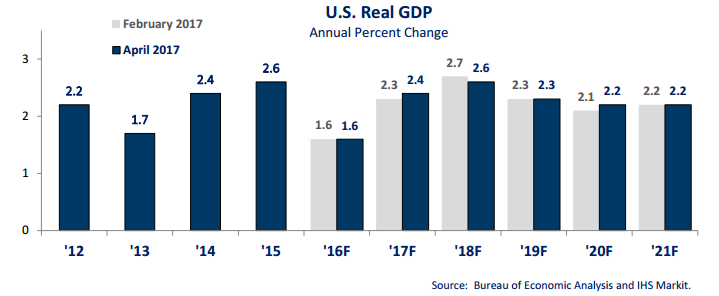This week’s April Revenue and Economic Update gave us some good news about the state’s economic and budget landscape. The quarterly report from Minnesota Management and Budget (MMB) showed that state revenues have come in above projections and national economic growth is expected to be on track with earlier projections for the next few years.
1. Recent revenues are above projections. February and March 2017 revenues came in $23 million above projections; that’s 0.9 percent more than projected in the February 2017 Economic Forecast. This is due primarily to higher than expected income tax receipts, which the Update notes could be a timing issue that evens out as the filing season progresses.
2. Continued national economic growth projected for 2017 and onward. In 2017, the U.S. economy is growing about as predicted in the February forecast, at 2.4 percent. The Update expects 2.6 percent growth in 2018, then settle to a little over 2.0 percent yearly growth from 2019 to 2021.

3. The national economy is improving. The latest jobs numbers show that the U.S. labor market continues to improve, and nationally, unemployment is expected to drop to 4.0 percent by 2019.
4. Significant areas of uncertainty remain. The Update notes there is not enough information to incorporate the potential impact of federal policy changes to health care, immigration, trade, and business investment incentives into their economic model. These caveats aside, the forecasters assign a 60 percent chance to their baseline forecast. They also give a 25 percent chance for a more pessimistic scenario where the U.S. sees a brief recession in 2018 as trade relations worsen and businesses delay investment. They assign a 15 percent probability to a more optimistic scenario where economic growth is strengthened due to business investment in productivity.
5. Policymakers should be cautious. This week’s Update continues the trend of good budget news for Minnesota. But policymakers should practice great caution as they make budget decisions in the closing weeks of the Legislative Session, as there is considerable uncertainty around policy changes at the federal level. And given the relatively unprecedented length of the current economic recovery, it’s likely that the next recession is not too far away. President Donald Trump has proposed and the U.S. House has considered deep cuts to the safety net and to state funding. For example, for the upcoming federal fiscal year Trump proposes about $18 billion in cuts to grants to states and local governments that support critical services, such as housing and poverty-reduction efforts. Minnesota policymakers should prepare for an uncertain future by not making large and unsustainable tax cuts or weakening the state’s budget reserve.
By Clark Biegler